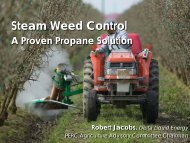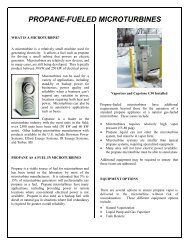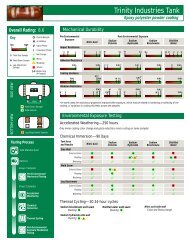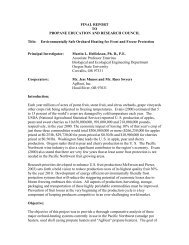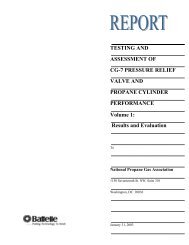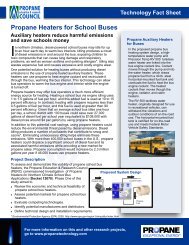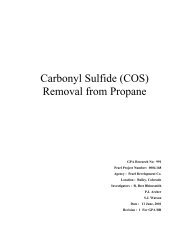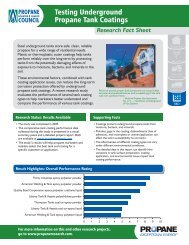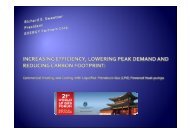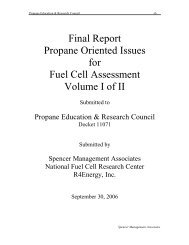Code Approval of Composite Propane Cylinders for Indoor Use ...
Code Approval of Composite Propane Cylinders for Indoor Use ...
Code Approval of Composite Propane Cylinders for Indoor Use ...
You also want an ePaper? Increase the reach of your titles
YUMPU automatically turns print PDFs into web optimized ePapers that Google loves.
esulting in flashover conditions in the test room. In one test, an additional spare cylinder waspositioned next to the heater to evaluate the effects <strong>of</strong> radiant heat on the composite cylinder.The increases in temperatures, ensuing from the fire growth, were measured and the per<strong>for</strong>mance<strong>of</strong> the heating appliance was assessed.The final test was to assess the per<strong>for</strong>mance <strong>of</strong> a burning pressurized cylinder when impacted bya water hose stream. Two igniters were attached to a composite cylinder, filled to half <strong>of</strong> itscapacity with water, was pressurized by nitrogen following a predetermined cylinder pressuretimecurve obtained in Type-2 tests. The cylinder was impacted by a water hose stream when acylinder pressure <strong>of</strong> 220 psig was reached, six minutes into the test. The cylinder breachedbe<strong>for</strong>e the hose stream impact. However, the hose stream impact did not cause additional damageto the cylinder.The key findings <strong>of</strong> the second test program were:Fire hazard from empty or filled stored cylinder:1. The maximum heat release rates from the ignition and burning <strong>of</strong> the empty cylinderswere approximately 100-120 kW.2. The maximum smoke release rates were 0.65 m 3 /s <strong>for</strong> cylinders from onemanufacturer and 2.65 m 3 /s <strong>for</strong> the other manufacturer’s cylinders.3. A full stored cylinder sustained the radiant heat from a 300 kW fire <strong>for</strong> 20 minuteswithout being ignited or leaking propane (Type-3 test).4. A burning, nitrogen pressurized stored cylinder did not violently breach or rupturewhen impacted with a water hose stream.Contribution <strong>of</strong> leaking gas from an ignited cylinder to fire hazards in a room fire:5. In each <strong>of</strong> the fire tests (Type-2), the ignited composite cylinder in the heaterassembly released gas resulting in flashover conditions in the room.6. In a growing room fire that goes to flashover (Type-3), the composite cylinderbreached and ignited after the flashover had occurred. Typically, there was a three t<strong>of</strong>ive minute lag. between room flashover and breach <strong>of</strong> the cylinder. The leaking gascylinder did not rupture.7. Once the cylinder started to leak, the release <strong>of</strong> gas continued during the test. A fullcylinder was emptied approximately 10 to 15 minutes after the maximum pressurewas reached.Rupture hazard from propane filled cylinder:8. Cylinder design played a role in its fire per<strong>for</strong>mance. In one <strong>of</strong> the Type-2 tests, arupture <strong>of</strong> a two-piece cylinder occurred 17 minutes into the test, at a pressure <strong>of</strong> 46psig. The rupture occurred when the pressure level was decaying; eight minutes afterthe pressure had reached its maximum level <strong>of</strong> 243 psig. The burst resulted in severe<strong>Composite</strong> <strong>Propane</strong> <strong>Cylinders</strong> vii February 2007<strong>for</strong> <strong>Indoor</strong> <strong>Use</strong> — Phase IIBattelle



